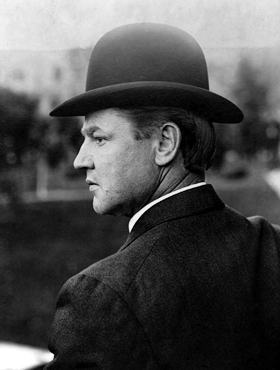Dublin Core
Title
Description
“Big Bill” Haywood was a legendary Utah labor leader, whose ashes were buried in the Kremlin Wall.
In February 1869, William D. Haywood was born in Salt Lake City into a working class family. He would grow up to become “Big Bill” Haywood, one of the most influential and infamous labor leaders in American history.
As a young boy, Haywood lost his father, was blinded in one eye, and was briefly indentured by his uncle to a farmer. He later bounced between jobs, working in the mines at Ophir and Bingham, surveying, cowboying, and even selling real estate. By his late twenties, Haywood had moved to Idaho to work as a silver miner. It was there that he became a labor organizer with the Western Federation of Miners, rising through its ranks until he was elected secretary-treasurer in 1901.
Following a series of strike defeats, Haywood began flirting with labor radicalism, calling for “One Big Union” to organize workers across industrial boundaries. His vision was realized when the Industrial Workers of the World union – otherwise known as the Wobblies – was born in Chicago in 1905. Wobbly success with Western miners and timber workers can be credited to Haywood’s leadership and fiery oratory skills.
Proponents of law and order soon zeroed in on Haywood, labeling him a dangerous influence. In 1906, he was implicated in the murder of former Idaho governor, Frank Steunenberg. Although clearly acquitted, Haywood remained a target of angry businessmen and suspicious politicians for the rest of his life.
When he was found guilty on federal charges of sedition for calling on workers to strike during World War I, Haywood appealed to the US Supreme Court. He lost – and then fled to the Soviet Union, where he was hailed as a working-class hero. “Big Bill” Haywood died in Moscow in 1928. Following his cremation, half of his ashes were interred in the wall of the Kremlin, the center of Soviet power, while the rest were returned to Chicago.
Creator
Source
Image: "Big Bill" Haywood, early twentieth-century. Image courtesy Wikipedia.
___________
See Jeffrey Nichols, “This Radical Salt Lake Native Was Interred in the Kremlin Wall,” History Blazer, June 1995, https://heritage.utah.gov/tag/big-bill-haywood; Andrew Hunt, “Beyond the Spotlight: The Red Scare in Utah,” Utah Historical Quarterly 61 (1993); Melvyn Dubofsky, “Big Bill” Haywood (New York, 1987); William D. Haywood, The Autobiography of Big Bill Haywood, New York: International Publishers, 1929; for more on Haywood and the murder of Frank Steunenberg, see J. Anthony Lukas, Big Trouble: A Murder in a Small Western Town Sets off a Struggle for the Soul of America (New York: Simon and Schuster, 1997).

